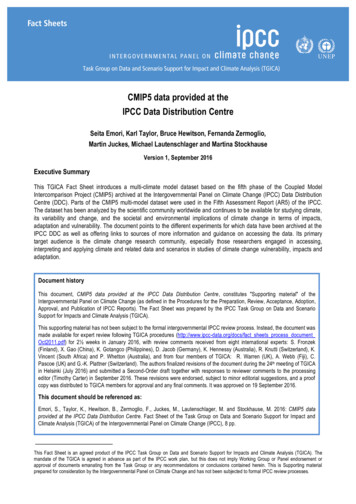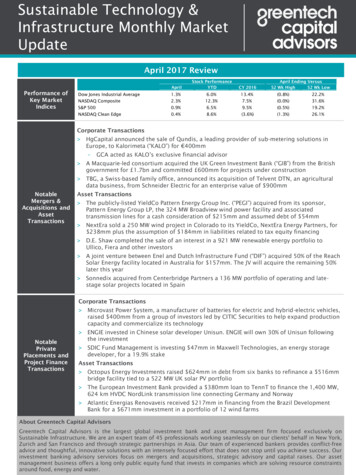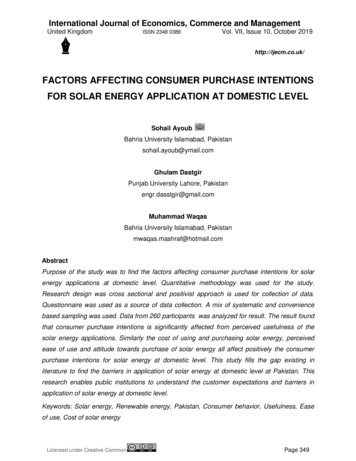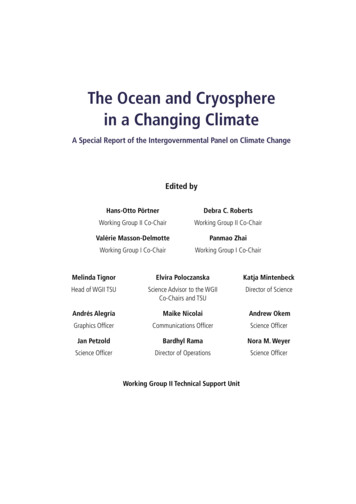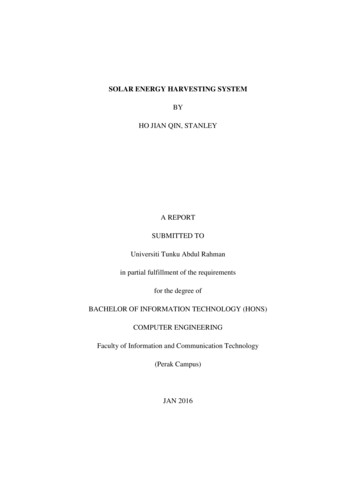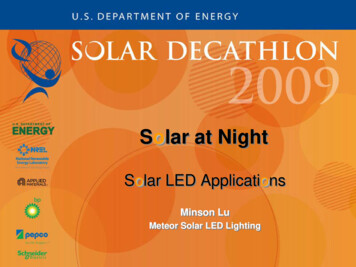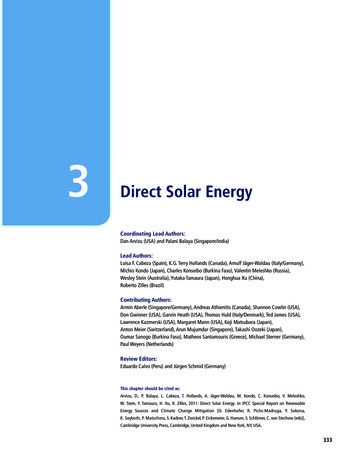
Transcription
Chapter 33Direct Solar EnergyCoordinating Lead Authors:Dan Arvizu (USA) and Palani Balaya (Singapore/India)Lead Authors:Luisa F. Cabeza (Spain), K.G. Terry Hollands (Canada), Arnulf Jäger-Waldau (Italy/Germany),Michio Kondo (Japan), Charles Konseibo (Burkina Faso), Valentin Meleshko (Russia),Wesley Stein (Australia), Yutaka Tamaura (Japan), Honghua Xu (China),Roberto Zilles (Brazil)Contributing Authors:Armin Aberle (Singapore/Germany), Andreas Athienitis (Canada), Shannon Cowlin (USA),Don Gwinner (USA), Garvin Heath (USA), Thomas Huld (Italy/Denmark), Ted James (USA),Lawrence Kazmerski (USA), Margaret Mann (USA), Koji Matsubara (Japan),Anton Meier (Switzerland), Arun Mujumdar (Singapore), Takashi Oozeki (Japan),Oumar Sanogo (Burkina Faso), Matheos Santamouris (Greece), Michael Sterner (Germany),Paul Weyers (Netherlands)Review Editors:Eduardo Calvo (Peru) and Jürgen Schmid (Germany)This chapter should be cited as:Arvizu, D., P. Balaya, L. Cabeza, T. Hollands, A. Jäger-Waldau, M. Kondo, C. Konseibo, V. Meleshko,W. Stein, Y. Tamaura, H. Xu, R. Zilles, 2011: Direct Solar Energy. In IPCC Special Report on RenewableEnergy Sources and Climate Change Mitigation [O. Edenhofer, R. Pichs-Madruga, Y. Sokona,K. Seyboth, P. Matschoss, S. Kadner, T. Zwickel, P. Eickemeier, G. Hansen, S. Schlömer, C. von Stechow (eds)],Cambridge University Press, Cambridge, United Kingdom and New York, NY, USA.333
Direct Solar EnergyChapter 3Table of ContentsExecutive Summary . . . . . . . . . . . . . . . . . . . . . . . . . . . . . . . . . . . . . . . . . . . . . . . . . . . . . . . . . . . . . . . . . . . . . . . . . . . . . . . . . . . . . . . . . . . . . . . . . . . . . . . . . . . . . . . . . . . . . . . . . . . . . . . . . . . . . . . . . . . . . 3373.1Introduction . . . . . . . . . . . . . . . . . . . . . . . . . . . . . . . . . . . . . . . . . . . . . . . . . . . . . . . . . . . . . . . . . . . . . . . . . . . . . . . . . . . . . . . . . . . . . . . . . . . . . . . . . . . . . . . . . . . . . . . . . . . . . . . . . . . . . . . . . 3403.2Resource potential . . . . . . . . . . . . . . . . . . . . . . . . . . . . . . . . . . . . . . . . . . . . . . . . . . . . . . . . . . . . . . . . . . . . . . . . . . . . . . . . . . . . . . . . . . . . . . . . . . . . . . . . . . . . . . . . . . . . . . . . . . . . . . 3413.2.1Global technical potential . . . . . . . . . . . . . . . . . . . . . . . . . . . . . . . . . . . . . . . . . . . . . . . . . . . . . . . . . . . . . . . . . . . . . . . . . . . . . . . . . . . . . . . . . . . . . . . . . . . . . . . . . . . . . . . . . . . . . . . . . . . 3413.2.2Regional technical potential3.2.3Sources of solar irradiance data3.2.4Possible impact of climate change on resource potential . . . . . . . . . . . . . . . . . . . . . . . . . . . . . . . . . . . . . . . . . . . . . . . . . . . . . . . . . . . . . . . . . . . . . . . . . . . . . . . . . 3433.3Technology and applications . . . . . . . . . . . . . . . . . . . . . . . . . . . . . . . . . . . . . . . . . . . . . . . . . . . . . . . . . . . . . . . . . . . . . . . . . . . . . . . . . . . . . . . . . . . . . . . . . . . . . . . . . . . . . 3433.3.1Passive solar and daylighting technologies . . . . . . . . . . . . . . . . . . . . . . . . . . . . . . . . . . . . . . . . . . . . . . . . . . . . . . . . . . . . . . . . . . . . . . . . . . . . . . . . . . . . . . . . . . . . . . . . . . . . 3443.3.23.3.2.13.3.2.23.3.2.33.3.2.4Active solar heating and cooling . . . . . . . . . . . . . . . . . . . . . . . . . . . . . . . . . . . . . . . . . . . . . . . . . . . . . . . . . . . . . . . . . . . . . . . . . . . . . . . . . . . . . . . . . . . . . . . . . . . . . . . . . . . . . . . . . . 346Solar heating . . . . . . . . . . . . . . . . . . . . . . . . . . . . . . . . . . . . . . . . . . . . . . . . . . . . . . . . . . . . . . . . . . . . . . . . . . . . . . . . . . . . . . . . . . . . . . . . . . . . . . . . . . . . . . . . . . . . . . . . . . . . . . . . . . . . . . . . . . . . . . 346Solar cooling . . . . . . . . . . . . . . . . . . . . . . . . . . . . . . . . . . . . . . . . . . . . . . . . . . . . . . . . . . . . . . . . . . . . . . . . . . . . . . . . . . . . . . . . . . . . . . . . . . . . . . . . . . . . . . . . . . . . . . . . . . . . . . . . . . . . . . . . . . . . . . 349Thermal storage . . . . . . . . . . . . . . . . . . . . . . . . . . . . . . . . . . . . . . . . . . . . . . . . . . . . . . . . . . . . . . . . . . . . . . . . . . . . . . . . . . . . . . . . . . . . . . . . . . . . . . . . . . . . . . . . . . . . . . . . . . . . . . . . . . . . . . . . . . 349Active solar heating and cooling applications . . . . . . . . . . . . . . . . . . . . . . . . . . . . . . . . . . . . . . . . . . . . . . . . . . . . . . . . . . . . . . . . . . . . . . . . . . . . . . . . . . . . . . . . . . . . . . . . . . . . . . ltaic electricity generation . . . . . . . . . . . . . . . . . . . . . . . . . . . . . . . . . . . . . . . . . . . . . . . . . . . . . . . . . . . . . . . . . . . . . . . . . . . . . . . . . . . . . . . . . . . . . . . . . . . . . . . . . . . . . . 351Existing photovoltaic technologies . . . . . . . . . . . . . . . . . . . . . . . . . . . . . . . . . . . . . . . . . . . . . . . . . . . . . . . . . . . . . . . . . . . . . . . . . . . . . . . . . . . . . . . . . . . . . . . . . . . . . . . . . . . . . . . . . . . . 351Emerging photovoltaic technologies . . . . . . . . . . . . . . . . . . . . . . . . . . . . . . . . . . . . . . . . . . . . . . . . . . . . . . . . . . . . . . . . . . . . . . . . . . . . . . . . . . . . . . . . . . . . . . . . . . . . . . . . . . . . . . . . . 352Novel photovoltaic technologies . . . . . . . . . . . . . . . . . . . . . . . . . . . . . . . . . . . . . . . . . . . . . . . . . . . . . . . . . . . . . . . . . . . . . . . . . . . . . . . . . . . . . . . . . . . . . . . . . . . . . . . . . . . . . . . . . . . . . . 353Photovoltaic systems . . . . . . . . . . . . . . . . . . . . . . . . . . . . . . . . . . . . . . . . . . . . . . . . . . . . . . . . . . . . . . . . . . . . . . . . . . . . . . . . . . . . . . . . . . . . . . . . . . . . . . . . . . . . . . . . . . . . . . . . . . . . . . . . . . . . 353Photovoltaic applications . . . . . . . . . . . . . . . . . . . . . . . . . . . . . . . . . . . . . . . . . . . . . . . . . . . . . . . . . . . . . . . . . . . . . . . . . . . . . . . . . . . . . . . . . . . . . . . . . . . . . . . . . . . . . . . . . . . . . . . . . . . . . . . 3533.3.4Concentrating solar power electricity generation . . . . . . . . . . . . . . . . . . . . . . . . . . . . . . . . . . . . . . . . . . . . . . . . . . . . . . . . . . . . . . . . . . . . . . . . . . . . . . . . . . . . . . . . . . . 3553.3.5Solar fuel production3.4Global and regional status of market and industry development . . . . . . . . . . . . . . . . . . . . . . . . . . . . . . . . . . . . . . . . . . . . . . . 3593.4.1Installed capacity and generated energy . . . . . . . . . . . . . . . . . . . . . . . . . . . . . . . . . . . . . . . . . . . . . . . . . . . . . . . . . . . . . . . . . . . . . . . . . . . . . . . . . . . . . . . . . . . . . . . . . . . . . . . 3593.4.2Industry capacity and supply chain . . . . . . . . . . . . . . . . . . . . . . . . . . . . . . . . . . . . . . . . . . . . . . . . . . . . . . . . . . . . . . . . . . . . . . . . . . . . . . . . . . . . . . . . . . . . . . . . . . . . . . . . . . . . . . . 3623.4.3Impact of policies . . . . . . . . . . . . . . . . . . . . . . . . . . . . . . . . . . . . . . . . . . . . . . . . . . . . . . . . . . . . . . . . . . . . . . . . . . . . . . . . . . . . . . . . . . . . . . . . . . . . . . . . . . . . . . . . . . . . . . . . . . . . . . . . . . . . . . 366334.342342358
Chapter 3Direct Solar Energy3.5Integration into the broader energy system . . . . . . . . . . . . . . . . . . . . . . . . . . . . . . . . . . . . . . . . . . . . . . . . . . . . . . . . . . . . . . . . . . . . . . . . . . . . . . . . . . . 3673.5.1Low-capacity electricity demand . . . . . . . . . . . . . . . . . . . . . . . . . . . . . . . . . . . . . . . . . . . . . . . . . . . . . . . . . . . . . . . . . . . . . . . . . . . . . . . . . . . . . . . . . . . . . . . . . . . . . . . . . . . . . . . . . . 3673.5.2District heating and other thermal loads . . . . . . . . . . . . . . . . . . . . . . . . . . . . . . . . . . . . . . . . . . . . . . . . . . . . . . . . . . . . . . . . . . . . . . . . . . . . . . . . . . . . . . . . . . . . . . . . . . . . . . . 3673.5.3Photovoltaic generation characteristics and the smoothing effect3.5.4Concentrating solar power generation characteristics and grid stabilization . . . . . . . . . . . . . . . . . . . . . . . . . . . . . . . . . . . . . . . . . . . . . . . . . . . . . . . 3693.6Environmental and social impacts . . . . . . . . . . . . . . . . . . . . . . . . . . . . . . . . . . . . . . . . . . . . . . . . . . . . . . . . . . . . . . . . . . . . . . . . . . . . . . . . . . . . . . . . . . . . . . . . . . . . 3693.6.1Environmental impacts . . . . . . . . . . . . . . . . . . . . . . . . . . . . . . . . . . . . . . . . . . . . . . . . . . . . . . . . . . . . . . . . . . . . . . . . . . . . . . . . . . . . . . . . . . . . . . . . . . . . . . . . . . . . . . . . . . . . . . . . . . . . . . . 3693.6.2Social impacts3.7Prospects for technology improvements and innovation . . . . . . . . . . . . . . . . . . . . . . . . . . . . . . . . . . . . . . . . . . . . . . . . . . . . . . . . . . . . . . 3733.7.1Passive solar and daylighting technologies . . . . . . . . . . . . . . . . . . . . . . . . . . . . . . . . . . . . . . . . . . . . . . . . . . . . . . . . . . . . . . . . . . . . . . . . . . . . . . . . . . . . . . . . . . . . . . . . . . . . 3733.7.2Active solar heating and cooling . . . . . . . . . . . . . . . . . . . . . . . . . . . . . . . . . . . . . . . . . . . . . . . . . . . . . . . . . . . . . . . . . . . . . . . . . . . . . . . . . . . . . . . . . . . . . . . . . . . . . . . . . . . . . . . . . . 3743.7.3Photovoltaic electricity generation3.7.4Concentrating solar power electricity generation . . . . . . . . . . . . . . . . . . . . . . . . . . . . . . . . . . . . . . . . . . . . . . . . . . . . . . . . . . . . . . . . . . . . . . . . . . . . . . . . . . . . . . . . . . . 3773.7.5Solar fuel production3.7.6Other potential future applications3.8Cost trends3.8.1Passive solar and daylighting technologies . . . . . . . . . . . . . . . . . . . . . . . . . . . . . . . . . . . . . . . . . . . . . . . . . . . . . . . . . . . . . . . . . . . . . . . . . . . . . . . . . . . . . . . . . . . . . . . . . . . . 3783.8.2Active solar heating and cooling . . . . . . . . . . . . . . . . . . . . . . . . . . . . . . . . . . . . . . . . . . . . . . . . . . . . . . . . . . . . . . . . . . . . . . . . . . . . . . . . . . . . . . . . . . . . . . . . . . . . . . . . . . . . . . . . . . 3793.8.3Photovoltaic electricity generation3.8.4Concentrating solar power electricity generation . . . . . . . . . . . . . . . . . . . . . . . . . . . . . . . . . . . . . . . . . . . . . . . . . . . . . . . . . . . . . . . . . . . . . . . . . . . . . . . . . . . . . . . . . . . 3823.8.5Solar fuel production.368372375377.378.378.380385335
Direct Solar EnergyChapter 33.9Potential deployment . . . . . . . . . . . . . . . . . . . . . . . . . . . . . . . . . . . . . . . . . . . . . . . . . . . . . . . . . . . . . . . . . . . . . . . . . . . . . . . . . . . . . . . . . . . . . . . . . . . . . . . . . . . . . . . . . . . . . . . . . 3863.9.1Near-term forecasts . . . . . . . . . . . . . . . . . . . . . . . . . . . . . . . . . . . . . . . . . . . . . . . . . . . . . . . . . . . . . . . . . . . . . . . . . . . . . . . . . . . . . . . . . . . . . . . . . . . . . . . . . . . . . . . . . . . . . . . . . . . . . . . . . . . 3863.9.2Long-term deployment in the context of carbon mitigation3.9.3Conclusions regarding deployment.386.390References . . . . . . . . . . . . . . . . . . . . . . . . . . . . . . . . . . . . . . . . . . . . . . . . . . . . . . . . . . . . . . . . . . . . . . . . . . . . . . . . . . . . . . . . . . . . . . . . . . . . . . . . . . . . . . . . . . . . . . . . . . . . . . . . . . . . . . . . . . . . . . . . . . . . . . . . . . . . 391336
Chapter 3Direct Solar EnergyExecutive SummarySolar energy is abundant and offers significant potential for near-term (2020) and long-term (2050) climate change mitigation. There are a wide variety of solar technologies of varying maturities that can, in most regions of the world, contribute toa suite of energy services. Even though solar energy generation still only represents a small fraction of total energy consumption, markets for solar technologies are growing rapidly. Much of the desirability of solar technology is its inherentlysmaller environmental burden and the opportunity it offers for positive social impacts. The cost of solar technologies hasbeen reduced significantly over the past 30 years and technical advances and supportive public policies continue to offerthe potential for additional cost reductions. Potential deployment scenarios range widely—from a marginal role of directsolar energy in 2050 to one of the major sources of energy supply. The actual deployment achieved will depend on thedegree of continued innovation, cost reductions and supportive public policies.Solar energy is the most abundant of all energy resources. Indeed, the rate at which solar energy is intercepted bythe Earth is about 10,000 times greater than the rate at which humankind consumes energy. Although not all countriesare equally endowed with solar energy, a significant contribution to the energy mix from direct solar energy is possiblefor almost every country. Currently, there is no evidence indicating a substantial impact of climate change on regionalsolar resources.Solar energy conversion consists of a large family of different technologies capable of meeting a variety ofenergy service needs. Solar technologies can deliver heat, cooling, natural lighting, electricity, and fuels for a host ofapplications. Conversion of solar energy to heat (i.e., thermal conversion) is comparatively straightforward, because anymaterial object placed in the sun will absorb thermal energy. However, maximizing that absorbed energy and stoppingit from escaping to the surroundings can take specialized techniques and devices such as evacuated spaces, opticalcoatings and mirrors. Which technique is used depends on the application and temperature at which the heat is to bedelivered. This can range from 25 C (e.g., for swimming pool heating) to 1,000 C (e.g., for dish/Stirling concentratingsolar power), and even up to 3,000 C in solar furnaces.Passive solar heating is a technique for maintaining comfortable conditions in buildings by exploiting the solar irradiance incident on the buildings through the use of glazing (windows, sun spaces, conservatories) and other transparentmaterials and managing heat gain and loss in the structure without the dominant use of pumps or fans. Solar cooling forbuildings can also be achieved, for example, by using solar-derived heat to drive thermodynamic refrigeration absorptionor adsorption cycles. Solar energy for lighting actually requires no conversion since solar lighting occurs naturally in buildings through windows. However, maximizing the effect requires specialized engineering and architectural design.Generation of electricity can be achieved in two ways. In the first, solar energy is converted directly into electricity in adevice called a photovoltaic (PV) cell. In the second, solar thermal energy is used in a concentrating solar power (CSP)plant to produce high-temperature heat, which is then converted to electricity via a heat engine and generator. Bothapproaches are currently in use. Furthermore, solar driven systems can deliver process heat and cooling, and other solartechnologies are being developed that will deliver energy carriers such as hydrogen or hydrocarbon fuels—known assolar fuels.The various solar technologies have differing maturities, and their applicability depends on local conditionsand government policies to support their adoption. Some technologies are already competitive with market pricesin certain locations, and in general, the overall viability of solar technologies is improving. Solar thermal can be used fora wide variety of applications, such as for domestic hot water, comfort heating of buildings, and industrial process heat.This is significant, as many countries spend up to one-third of their annual energy usage for heat. Service hot waterheating for domestic and commercial buildings is now a mature technology growing at a rate of about 16% per yearand employed in most countries of the world. The world installed capacity of solar thermal systems at the end of 2009has been estimated to be 180 GWth.337
Direct Solar EnergyChapter 3Passive solar and daylighting are conserving energy in buildings at a highly significant rate, but the actual amount isdifficult to quantify. Well-designed passive solar systems decrease the need for additional comfort heating requirementsby about 15% for existing buildings and about 40% for new buildings.The generation of electricity using PV panels is also a worldwide phenomenon. Assisted by supportive pricing policies,the compound annual growth rate for PV production from 2003 to 2009 was more than 50%—making it one of thefastest-growing energy technologies in percentage terms. As of the end of 2009, the installed capacity for PV powerproduction was about 22 GW. Estimates for 2010 give a consensus value of about 13 GW of newly added capacity.Most of those installations are roof-mounted and grid-connected. The production of electricity from CSP installations hasseen a large increase in planned capacity in the last few years, with several countries beginning to experience significantnew installations.Integration of solar energy into broader energy systems involves both challenges and opportunities. Energyprovided by PV panels and solar domestic water heaters can be especially valuable because the energy productionoften occurs at times of peak loads on the grid, as in cases where there is a large summer daytime load associated withair conditioning. PV and solar domestic water heaters also fit well with the needs of many countries because they aremodular, quick to install, and can sometimes delay the need for costly construction or expansion of the transmission grid.At the same time, solar energy typically has a variable production profile with some degree of unpredictability that mustbe managed, and central-station solar electricity plants may require new transmission infrastructure. Because CSP can bereadily coupled with thermal storage, the production profile can be controlled to limit production variability and enabledispatch capability.Solar technologies offer opportunities for positive social impacts, and their environmental burden is small.Solar technologies have low lifecycle greenhouse gas emissions, and quantification of external costs has yielded favourable values compared to fossil fuel-based energy. Potential areas of concern include recycling and use of toxic materialsin manufacturing for PV, water usage for CSP, and energy payback and land requirements for both. An important socialbenefit of solar technologies is their potential to improve the health and livelihood opportunities for many of the world’spoorest populations—addressing some of the gap in availability of modern energy services for the roughly 1.4 billionpeople who do not have access to electricity and the 2.7 billion people who rely on traditional biomass for home cookingand heating needs. On the downside, some solar projects have faced public concerns regarding land requirements forcentralized CSP and PV plants, perceptions regarding visual impacts, and for CSP, cooling water requirements. Land useimpacts can be minimized by selecting areas with low population density and low environmental sensitivity. Similarly,water usage for CSP could be significantly reduced by using dry cooling approaches. Studies to date suggest that none ofthese issues presents a barrier against the widespread use of solar technologies.Over the last 30 years, solar technologies have seen very substantial cost reductions. The current levelized costsof energy (electricity and heat) from solar technologies vary widely depending on the upfront technology cost, availablesolar irradiation as well as the applied discount rates. The levelized costs for solar thermal energy at a 7% discount raterange between less than USD2005 10 and slightly more than USD2005 20/GJ for solar hot water generation with a highdegree of utilization in China to more than USD2005 130/GJ for space heating applications in Organisation for EconomicCo-operation and Development (OECD) countries with relative low irradiation levels of 800 kWh/m2/yr. Electricity generation costs for utility-scale PV in regions of high solar irradiance in Europe and the USA are in the range of approximately15 to 40 US cents2005 /kWh at a 7% discount rate, but may be lower or higher depending on the available resource andon other framework conditions. Current cost data are limited for CSP and are highly dependent on other system factorssuch as storage. In 2009, the levelized costs of energy for large solar troughs with six hours of thermal storage rangedfrom below 20 to approximately 30 US cents2005 /kWh. Technological improvements and cost reductions are expected, butthe learning curves and subsequent cost reductions of solar technologies depend on production volume, research and338
Chapter 3Direct Solar Energydevelopment (R&D), and other factors such as access to capital, and not on the mere passage of time. Private capital isflowing into all the technologies, but government support and stable political conditions can lessen the risk of privateinvestment and help ensure faster deployment.Potential deployment scenarios for solar energy range widely—from a marginal role of direct solar energy in2050 to one of the major sources of global energy supply. Although it is true that direct solar energy provides onlya very small fraction of global energy supply today, it has the largest technical potential of all energy sources. In concertwith technical improvements and resulting cost reductions, it could see dramatically expanded use in the decades tocome. Achieving continued cost reductions is the central challenge that will influence the future deployment of solarenergy. Moreover, as with some other forms of renewable energy, issues of variable production profiles and energymarket integration as well as the possible need for new transmission infrastructure will influence the magnitude, typeand cost of solar energy deployment. Finally, the regulatory and legal framework in place can also foster or hinder theuptake of direct solar energy applications.339
Direct Solar Energy3.1IntroductionThe aim of this chapter is to provide a synopsis of the state-of-the-artand possible future scenarios of the full realization of direct solar energy’s potential for mitigating climate change. It establishes the resourcebase, describes the many and varied technologies, appraises currentmarket development, outlines some methods for integrating solar intoother energy systems, addresses its environmental and social impacts,and finally, evaluates the prospects for future deployment.Some of the solar energy absorbed by the Earth appears later in the formof wind, wave, ocean thermal, hydropower and excess biomass energies.The scope of this chapter, however, does not include these other indirectforms. Rather, it deals with the direct use of solar energy.Various books have been written on the history of solar technology (e.g.,Butti and Perlin, 1980). This history began when early civilizations discovered that buildings with openings facing the Sun were warmer andbrighter, even in cold weather. During the late 1800s, solar collectors forheating water and other fluids were invented and put into practical usefor domestic water heating and solar industrial applications, for example,large-scale solar desalination. Later, mirrors were used (e.g., by AugustinMouchot in 1875) to boost the available fluid temperature, so that heatengines driven by the Sun could develop motive power, and thence, electrical power. Also, the late 1800s brought the discovery of a device forconverting sunlight directly into electricity. Called the photovoltaic (PV)cell, this device bypassed the need for a heat engine. The modern siliconsolar cell, attributed to Russell Ohl working at American Telephone andTelegraph’s (AT&T) Bell Labs, was discovered around 1940.The modern age of solar research began in the 1950s with the establishment of the International Solar Energy Society (ISES) and increasedresearch and development (R&D) efforts in many industries. For example,advances in the solar hot water heater by companies such as Miromit inIsrael and the efforts of Harry Tabor at the National Physical Laboratoryin Jerusalem helped to make solar energy the standard method forproviding hot water for homes in Israel by the early 1960s. At aboutthe same time, national and international networks of solar irradiancemeasurements were beginning to be established. With the oil crisis ofthe 1970s, most countries in the world developed programs for solarenergy R&D, and this involved efforts in industry, government labs anduniversities. These policy support efforts, which have, for the most part,continued up to the present, have borne fruit: now one of the fastestgrowing renewable energy (RE) technologies, solar energy is poised toplay a much larger role on the world energy stage.Solar energy is an abundant energy resource. Indeed, in just one hour,the solar energy intercepted by the Earth exceeds the world’s energyconsumption for the entire year. Solar energy’s potential to mitigate climate change is equally impressive. Except for the modest amount ofcarbon dioxide (CO2) emissions produced in the manufacture of conversion devices (see Section 3.6.1) the direct use of solar energy produces340Chapter 3very little greenhouse gases, and it has the potential to displace largequantities of non-renewable fuels (Tsilingiridis et al., 2004).Solar energy conversion is manifest in a family of technologies havinga broad range of energy service applications: lighting, comfort heating, hot water for buildings and industry, high-temperature solar heatfor electric power and industry, photovoltaic conversion for electricalpower, and production of solar fuels, for example, hydrogen or synthesisgas (syngas). This chapter will further detail all of these technologies.Several solar technologies, such as domestic hot water heating andpool heating, are already competitive and used in locales where theyoffer the least-cost option. And in jurisdictions where governments havetaken steps to actively support solar energy, very large solar electricity(both PV and CSP) installations, approaching 100 MW of power, havebeen realized, in addition to large numbers of rooftop PV installations.Other applications, such as solar fuels, require additional R&D beforeachieving significant levels of adoption.In pursuing any of the solar technologies, there is the need to deal withthe variability and the cyclic nature of the Sun. One option is to storeexcess collected energy until it is needed. This is particularly effective forhandling the lack of sunshine at night. For example, a 0.1-m thick slabof concrete in the floor of a home will store much of the solar energyabsorbed during the day and release it to the room at night. Whentotalled over a long period of time such as one year, or over a largegeographical area such as a continent, solar energy can offer greaterservice. The use of both these concepts of time and space, together withenergy storage, has enabled designers to produce more effective solarsystems. But much more work is needed to capture the full value of solarenergy’s contribution.Because of its inherent variability, solar energy is most useful when integrated with another energy source, to be used when solar energy is notavailable. In the past, that source has generally been a non-renewableone. But there is great potential for integrating direct solar energy withother RE technologies.The rest of this chapter will include the following topics. Section 3.2summarize
Direct Solar Energy Chapter 3 Passive solar and daylighting are conserving energy in buildings at a highly signifi cant rate, but the actual amount is diffi cult to quantify. Well-designed passive solar systems decrease the need for additional comfort heating requirements by about 15% for existing buildings and about 40% for new buildings.
